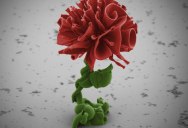Self-Assembling Nano Flowers Grown in Lab
At a laboratory at Harvard University, scientists have grown complex self-assembling nano- and microstructures using a solution of chemicals and minerals. Some of the structures are smaller than the width of a human hair and have many potential uses in optics and engineering.
Researchers have started with flowers, stems and vases as they were the easiest shape to start with. By changing the temperature, pH, and carbon dioxide content of the chemical solutions, researchers were able to manipulate and control the growth of the structures.
In an upcoming paper published in Science, lead scientist Wim Noorduin explains:
“The emergence of complex nano- and microstructures is of fundamental interest, and the ability to program their form has practical ramifications in fields such as optics, catalysis, and electronics. We developed carbonate-silica microstructures in a dynamic reaction-diffusion system that allow us to rationally devise schemes for precisely sculpting a great variety of elementary shapes by diffusion of carbon dioxide (CO2) in a solution of barium chloride and sodium metasilicate.
We identify two distinct growth modes and show how continuous and discrete modulations in CO2 concentration, pH, and temperature can be used to deterministically switch between different regimes and create a bouquet of hierarchically assembled multiscale microstructures with unprecedented levels of complexity and precision. These results outline a nanotechnology strategy for “collaborating” with self-assembly processes in real-time to build arbitrary tectonic architectures.”
[Slideshow from Science, Science via National Geographic]
1.

2.

3.

4.

5.

6.

7.

8.

9.

10.

11.

12.

13.

14.

15.

16.

17.

18.

19.

20.

If you enjoyed this post, the Sifter
highly recommends:

Sign up to get our BEST stories of the week straight to your inbox.




